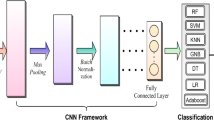Abstract
In this paper, the authors are classifying time series electroencephalogram (EEG) data as epilepsy or not. Epilepsy is a type neurological disorder which affects around one percentage of the people around the world. Epilepsy is diagnosed by electroencephalographic (EEG) reading of the brain. EEG monitors the electrical activity of the brain. Studying EEG is a time-consuming and tedious task and requires lots of patience and domain knowledge. Deep learning techniques can help us reduce and automate this task and make its detection easier for doctors which in turn can help doctors to give better treatment to the patient. In this paper, the authors propose a sequential one-dimensional convolutional neural network (CNN) and state-of-the-art architectures like one-dimensional inception module and one-dimensional ResNet module which will classify time series EEG data as epilepsy or not. Using these approaches, sequential model was able to outperform the state-of-the-art models and achieved a ROC-AUC of 0.98.
Access this chapter
Tax calculation will be finalised at checkout
Purchases are for personal use only
Similar content being viewed by others
References
Duncan JS, Sander JW, Sisodiya SM, Walker MC (2006) Adult epilepsy. Lancet 367(9516):1087–1100
LeCun Y, Bengio Y, Hinton G (2015) Deep learning. Nature 521(7553):436–444
Cui Z, Chen W, Chen Y (2016) Multi-scale convolutional neural networks for time series classification. arXiv preprint arXiv:1603.06995
Szegedy C, Liu W, Jia Y, Sermanet P, Reed S, Anguelov D, Erhan D, Vanhoucke V, Rabinovich A (2015) Going deeper with convolutions. In: Proceedings of the IEEE conference on computer vision and pattern recognition, pp 1–9
He K, Zhang X, Ren S, Sun J (2016) Deep residual learning for image recognition. In: Proceedings of the IEEE conference on computer vision and pattern recognition, pp 770–778
Guha A et al (2020) Epileptic seizure recognition using deep neural network. In: Emerging technology in modelling and graphics. Springer, Singapore, pp 21–28
Johansen AR, Jin J, Maszczyk T, Dauwels J, Cash SS, Westover MB (2016) Epileptiform spike detection via convolutional neural networks. In: 2016 IEEE international conference on acoustics, speech and signal processing (ICASSP), Shanghai, pp 754–758. https://doi.org/10.1109/ICASSP.2016.7471776
Hearst MA, Dumais ST, Osman E, Platt J, Scholkopf B (1998) Support vector machines. IEEE Intell Syst Appl 13(4):18–28
Svetnik V, Liaw A, Tong C, Culberson JC, Sheridan RP, Feuston BP (2003) Random forest: a classification and regression tool for compound classification and QSAR modeling. J Chem Inform Comput Sci 43(6):1947–1958
Peterson LE (1883) K-nearest neighbor. Scholarpedia 4(2):1883
Ross Quinlan J (1986) Induction of decision trees. Mach Learn 1(1):81–106
Lasefr Z, Reddy RR, Elleithy K (2017) Smart phone application development for monitoring epilepsy seizure detection based on EEG signal classification. In: 2017 IEEE 8th annual ubiquitous computing, electronics and mobile communication conference (UEMCON), New York, NY, pp 83–87. https://doi.org/10.1109/UEMCON.2017.8248992
Rashid MM, Ahmad M (2017) Epileptic seizure classification using statistical features of EEG signal. In: 2017 international conference on electrical, computer and communication engineering (ECCE), Cox’s Bazar, 2017, pp 308–312. https://doi.org/10.1109/ECACE.2017.7912923
Abuimara A (2015) A new method for predicting epilepsy seizure. In: 2015 IEEE 4th Portuguese meeting on bioengineering (ENBENG), Porto, 2015, pp 1–4. https://doi.org/10.1109/ENBENG.2015.7088840
Aileni RM, Paşca S, Florescu A (2019) Epileptic seizure classification based on supervised learning models. In: 2019 11th international symposium on advanced topics in electrical engineering (ATEE), Bucharest, Romania, pp 1-4. https://doi.org/10.1109/ATEE.2019.8725004
Fawaz HI, Lucas B, Forestier G, Pelletier C, Schmidt DF, Weber J, Geoffrey I, Webb LI, Pierre-Alain M, Petitjean F (2019) InceptionTime: finding AlexNet for time series classification. arXiv preprint arXiv:1909.04939
Torlay L, Perrone-Bertolotti M, Thomas E, Baciu M (2017) Machine learning–XGBoost analysis of language networks to classify patients with epilepsy. Brain Inform 4(3):159–169
Hussein R, Palangi H, Ward R, Wang ZJ (2018) Epileptic seizure detection: a deep learning approach. arXiv preprint arXiv:1803.09848
Birjandtalab J, Heydarzadeh M, Nourani M (2017) Automated EEG based epileptic seizure detection using deep neural networks. In: 2017 IEEE international conference on healthcare informatics (ICHI), Park City, UT, pp 552–555. https://doi.org/10.1109/ICHI.2017.55
Raghu S, Sriraam N, Temel Y, Rao SV, Kubben PL (2020) EEG based multi-class seizure type classification using convolutional neural network and transfer learning. Neural Netw 124:202–212
Rosas-Romero R, Guevara E, Peng K, Nguyen DK, Lesage F, Pouliot P, Lima-Saad WE (2019) Prediction of epileptic seizures with convolutional neural networks and functional near-infrared spectroscopy signals. Comput Biol Med 111:103355
Taherisadr M, Joneidi M, Rahnavard N (2019) EEG signal dimensionality reduction and classification using tensor decomposition and deep convolutional neural networks. In: 2019 IEEE 29th international workshop on machine learning for signal processing (MLSP). IEEE, pp 1–6
Zhang X, Yao L, Dong M, Liu Z, Zhang Y, Li Y (2020) Adversarial representation learning for robust patient-independent epileptic seizure detection. IEEE J Biomed Health Inf 24(10):2852–2859
Dua D, Graff C (2019) UCI machine learning repository. http://archive.ics.uci.edu/ml. University of California, School of Information and Computer Science, Irvine, CA
Chollet F (2015) Keras. https://keras.io
Kingma DP, Ba J (2014) Adam: a method for stochastic optimization. CoRR, abs/1412.6980 [Online]. Available: http://arxiv.org/abs/1412.6980
Grosse R (2017) Lecture 15: exploding and vanishing gradients. University of Toronto Computer Science
Pedregosa G et al (2011) Scikit-learn: machine learning in python. JMLR 12:2825–2830
Author information
Authors and Affiliations
Editor information
Editors and Affiliations
Rights and permissions
Copyright information
© 2022 The Author(s), under exclusive license to Springer Nature Singapore Pte Ltd.
About this paper
Cite this paper
Manocha, G., Rustagi, H., Singh, S.P., Jain, R., Nagrath, P. (2022). Epilepsy Seizure Classification Using One-Dimensional Convolutional Neural Networks. In: Sharma, N., Chakrabarti, A., Balas, V.E., Bruckstein, A.M. (eds) Data Management, Analytics and Innovation. Lecture Notes on Data Engineering and Communications Technologies, vol 71. Springer, Singapore. https://doi.org/10.1007/978-981-16-2937-2_12
Download citation
DOI: https://doi.org/10.1007/978-981-16-2937-2_12
Published:
Publisher Name: Springer, Singapore
Print ISBN: 978-981-16-2936-5
Online ISBN: 978-981-16-2937-2
eBook Packages: Intelligent Technologies and RoboticsIntelligent Technologies and Robotics (R0)




